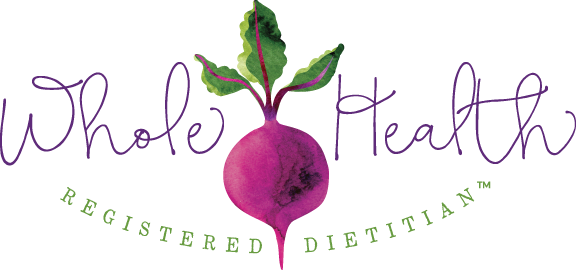I talk a lot about “hormone balance” in my blog posts and with my clients. People nod their heads enthusiastically when I mention this concept, but I wanted to write a little bit about what I mean when I say hormone balance. There are many hormones involved in human physiology – I’m going to focus on one in this post: estrogen. Estrogen actually refers to a whole family of hormones. There are estrogens that your body produces and estrogens you get from outside the body, like the synthetic estrogen in birth control and phytoestrogens from certain plants. And don’t forget about xenoestrogens, those endocrine-disrupting chemicals like BPA we hear about so often in the news. Xenoestrogens are found all around us, especially in what I like to call the “Four P’s”: pesticides, plastics, pollution, and personal care products.
Since the Women’s Health Initiative study results were released in 2002, which showed the detrimental effects of hormone replacement therapy (HRT) for women, the public’s and experts’ opinion of estrogen has been one of confusion.
Is estrogen a ¨bad” hormone? No, but it can quickly accumulate when the body isn’t functioning properly, and that’s when the problems begin.
“Excess estrogen” is a difficult concept for many of my clients to understand. They tell me, “oh, my doctor checked my estrogen levels and they are fine.” But our bodies can become overloaded with an excess of estrogen and estrogen-like chemicals in tissues, resulting in impaired fertility, PMS, endometriosis, fibrocystic breasts, miscarriages, problems breastfeeding, and increased risk of estrogen-related cancers.
Besides the health issues listed above, other signs and symptoms of excess estrogen include:
- Salt and fluid retention
- Impaired thyroid function
- Increased cortisol (belly fat!)
- Increased permeability of the gut (food allergies/sensitivities)
- Migraines
- Anxiety/depression
The American College of Obstetricians and Gynecologists (ACOG) and the American Society for Reproductive Medicine (ASRM) released an opinion paper on the topic in October 2013 (1). They concluded that the evidence that links exposure to xenoestrogens and adverse reproductive and developmental health outcomes is sufficiently robust, and that reducing exposure is a critical area of intervention for obstetricians, gynecologists, and other reproductive health care professionals.
My doctor never brought it up when I was pregnant or in the years before – did yours?
There are two main ways to address this issue, reduce exposure, and support good estrogen metabolism and detoxification. Here are my top evidence-based tips I give to clients to address both of these.
Reduce exposure:
- Buy organic fruits and vegetables on the “Dirty Dozen” list, and organic meat and dairy products.
- Lose weight. Excess estrogen is stored in fat tissue and excess fat can actually produce estrogen on its own.
- Avoid canned food, or choose BPA-free cans.
- Limit packaged, processed foods. Certain food additives are estrogenic (2).
- Limit soy, the most potent estrogenic food, and a known fertility inhibitor (3). Think you don’t eat soy? Yes you do. The average American, who is definitely not a tofu-eating vegetarian, gets up to 9% of their total calories from soybean oil alone (4). What about the Japanese, you say? Some experts believe their large tea intake protects them from the detrimental effects of soy. Plus, soy is only a small part of their diet. What about meat and dairy and their hormones? Both have a small fraction of the estrogenic compounds of soy, especially when you buy organic/grass-fed/pasture-raised meat and dairy. This deserves a blog post of its own. One day, I promise!
- Limit vegetable and seed oils. The accumulation of these oils in the tissues promotes the action of estrogen in a variety of ways, and this effect of this tends to be cumulative and self-accelerating. Use olive oil, butter, or coconut oil.
- Avoid fish with high mercury levels like swordfish, shark, tilefish, and king mackerel.
- Use natural cleaning products or make your own.
- Check your personal care products for ingredients like parabens and phthalates, or check them in the EWG Skin Deep database for endocrine safety.
- Consider alternatives to hormonal birth control.
Support good estrogen metabolism and detoxification:
- Adequate protein intake. Estrogen is mainly metabolized in the liver, where it’s made more water-soluble for excretion via urine and stool. Estrogen receptors in the liver are under the control of dietary protein. Government recommendations for protein are for surviving, not thriving. I tend to recommend a moderate protein intake of 25% of your daily calories – that usually equals 80-100g for most women, depending on weight and activity level. An easy way to make sure you’re getting enough without food logging? Include a concentrated protein source (at least 15g) at all of your meals and snacks – don’t skimp out at breakfast and lunch!
- One serving of cooked cruciferous vegetables a day, such as cabbage, cauliflower, broccoli, kale, collards, bok choy, etc. These contain indole-3-carbinol (I3C), which promotes estrogen metabolism. Cooking makes these vegetables easier to digest and better for the thyroid. Raw carrots also have anti-estrogenic properties.
- Have a bowel movement at least once a day. Regular bowel movements rid the body of excess estrogen. Letting stool sit in the colon allows excess estrogen to be reabsorbed into the bloodstream. You should not require the use of laxatives, fiber supplements, magnesium, or vitamin C overdosing, or other bowel-moving crutches. See me if this is an issue for you.
- Get enough fat-soluble vitamins (A, D, E, K). The American diet is notoriously low in these as I’ve written about in previous posts (5, 6). That’s a shame because all 4 have direct anti-estrogen action. Vitamins A, D and K are potent inhibitors of aromatase (the enzyme converting testosterone into estrogen) – so they will directly lower synthesis of new estrogen. Vitamin E will help counteract the effects of the already existing estrogen.
For a more specific, individualized plan, make an appointment with me.
“All of the unpleasant consequences of estrogen excess happen to resemble some of the events of aging.” – Dr. Raymond Peat
- https://www.acog.org/clinical/clinical-guidance/committee-opinion/articles/2013/10/exposure-to-toxic-environmental-agents#:~:text=The%20evidence%20that%20links%20exposure,and%20other%20clinical%20practitioners%20in
- http://www.scientificamerican.com/article/food-additives-mimic-hormones/
- http://www.ncbi.nlm.nih.gov/pmc/articles/PMC3074428/
- http://ajcn.nutrition.org/content/93/5/950.short
- https://wholehealthrd.com/facts-and-myths-regarding-vitamin-a/
- https://wholehealthrd.com/killer-calcium/






Is it safe for a post menopausal woman to start taking progesterone cream or use the ProgestE? I get spooked because I hear it can convert to estrogen at some point.
Ray Peat’s contention is that when progesterone takes a dive, it can bring on poor sugar oxidation and cause neuropathy, diabetes, etc. But if that was true, wouldn’t all post menopausal women have diabetes?
Would supplementing with progesterone eliminate the need to take thyroid hormone?
Ray also says that rubbing progesterone cream on the feet can ease neuropathy, but I’m always looking for the root cause. He claims it can regenerate nerves.
Thanks for your comment! I think progesterone should be used as a safe, but temporary aid. It can be very helpful to relieve symptoms as you work on changing your diet.